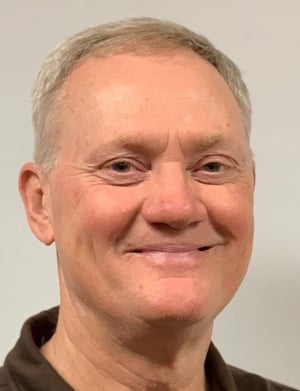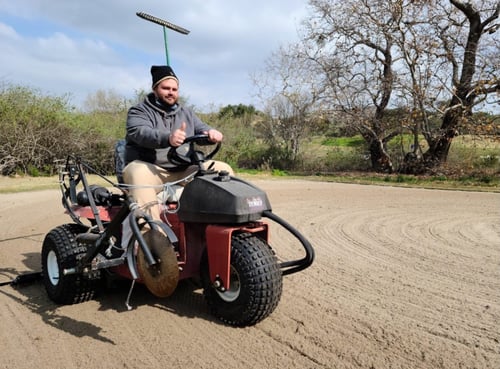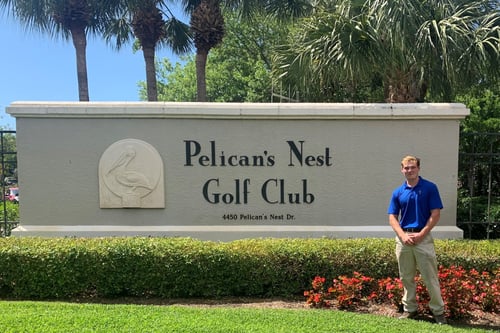Scoring a hole-in-one
Intern experiences aren't just par for the course. For MSU turf management students, golf courses provide the chance to expand their skills despite the COVID-19 pandemic.
Presented with the unique challenges caused by COVID-19, Michigan State University turf faculty in the Department of Plant, Soil and Microbial Sciences and the Institute of Agricultural Technology collaborated on a solution that could potentially benefit students, alumni and the golf industry.
Called “The Experiment” from the start, Professor John “Trey” Rogers III approached Brian Horgan, professor and chair of PSM, with the idea of finding turfgrass internships outside of Michigan during the spring semester starting in January 2021. With MSU classes continuing in remote formats, this would be a way for students to learn on premise at actual golf facilities while also taking online courses.

Discussions began in October 2020 and moved quickly. Rogers knew the facilities who had the resources to accommodate students, as well as the willingness to experiment with MSU. Many of Rogers’ industry connections are also MSU turf alumni who understand the value of in-person learning experiences.
“We needed nine golf facilities, and I made nine phone calls,” Rogers said. “I wasn’t giving them much time to react to this. All these superintendents said they’d take as many students as we wanted to send their way.”
During the spring 2021 semester, 16 turf students were matched and arrived at golf courses in Arizona, California, Florida and Texas. Turf students were part of the crop and soil sciences undergraduate program and the IAT golf course turf management certificate program.

“That’s really a testament to the alumni who have come out of this program,” Horgan said. “They realize that this is an experiment, but they trust Michigan State and they trust the faculty here. We’re trying something new and novel, and it might have some legs.”
Steady golf business
Typically, MSU coordinates compressed internships for students starting April 1, but having the students start in January, or in some cases even earlier, helped golf facilities this year as business in many states has been booming. Golfing has been viewed as a safe outdoor activity people could participate in while social distancing, so demand has remained steady throughout the pandemic.
“The labor market right now in the golf industry is really tight,” Horgan said. “Trey’s idea became really well timed. These golf courses are looking for high quality students and Michigan State has that reputation.”
John Nachreiner, director of agronomy, Shady Canyon Golf Club, Irvine, California, has two student interns at his course this spring. Nachreiner graduated from the MSU turf program in 2000 and appreciates how important internships are for both students and golf facilities.
“We are happy to interact with young students who are ready to put their knowledge to work,” he said. “Additionally, when an intern comes, then everyone on the team ups their game because they remember when they were interns. It brings up the collective game of everybody no matter what their position is.”
Nachreiner said his course has been busy, partly as a result of COVID-19. While the increased demand is good, it also comes with more golf carts since people are unable to share carts as a safety precaution.
“We’ve been really busy. For a long time, the golf course was one the few places you could still feel normal,” he said. “However, we needed to help people understand course conditions are not going to be the same as they were a year ago with the current increased golf cart traffic.”
Learning, then doing
For the spring 2021 internships, MSU faculty worked with participating golf course superintendents on what to expect and how they could help coordinate on-site work and labs with students’ in-class learning.
Students are taking four classes in addition to full-time internships at their respective golf courses. Three classes are on Tuesday and Thursday mornings, and one class is asynchronous. This enables students to learn first and then apply that knowledge in areas including turf equipment maintenance, grass planting, turf grooming, irrigation system calibration and pesticide and fertilizer application.

IAT student Trevor Stahl caught the turf bug after studying finance and interning with a financial planning company during his junior year. He realized finance wasn’t the right career direction for him. Stahl took a year off from school before discovering the two-year IAT certificate program.
“I’m 23 now and found out last July about the IAT turf golf management certificate program,” Stahl said. “Growing up, I had always golfed with my dad, but I got into turf much later, putting together my love of golf and the outdoors.”
Stahl had some experience in landscaping and a basic understanding of grass, but he said the turf classes and his internship at Shady Canyon Golf Club has taught him a lot in a short period.
“The superintendents are looking at our class schedules and helping connect the dots between what we’re learning and what we’re putting into practice,” Stahl said. “Overall my knowledge has grown exponentially. This internship has been really good.”
He’s also found a community among the small, close-knit group of turf students and faculty who have built a unique camaraderie through their experiences.
“I was definitely a little nervous coming out here. I was most nervous moving across the country, especially given everything that was going on,” Stahl said.
“Rogers wanted to make sure everyone was comfortable. He helped me realize I am a good fit for this program, and this is what I really love to do.”
COVID-19 has caused little disruption in daily operations at Pelican’s Nest Golf Club, Bonita Springs, Florida, and work has remained steady. MSU students rarely go to Florida during normal compressed April internships due to the seasonality, so the opportunity to host two student interns starting this January was a unique opportunity.Jason Zimmerman, director of greens and grounds at Pelican’s Nest, graduated from MSU in 1998. Helping MSU and its turf students appealed to him.
“It has been a great benefit to have students here working that are committed to learning more about not only what they are doing, but why they are doing it,” he said. “They proved to be very dedicated to working and were a great asset to the club.”
Zimmerman said there is nothing better than applied learning in the turf industry.
“One of the best things about this career is that it is constantly changing and we continue to learn every day,” he said. “To read something in a textbook or see it on a video does not take the place of getting dirty.”

Jackson Severns has been working at Pelican’s Nest since the fall 2020. Severns found his niche with the turf concentration in the crop and soil sciences major, but he also found remote classwork challenging when classes moved online in March 2020 due to COVID-19.
“I did not do well with the online school and took some time off,” he said. “Rogers helped connect me with Pelican’s Nest, and I started working there as an employee in September 2020. For the spring 2021 semester, I became an intern at Pelican’s Nest and took online turf classes that were directly applicable to my internship.”
Severns wants to be a superintendent or assistant superintendent at a golf course after he graduates. This internship has provided unique opportunities for him to interact with industry leaders, as well as learn applicable skills on the golf course.
“It’s nice to go to class, and then you go to work to learn more about pesticides, fertilizers, procedures, protocols, fungicides. Then you’re working right with the spray technicians at the golf course,” he said.
Wrapping up “The Experiment”
Rogers and Horgan reviewed the challenges of remote classes in the highly applied skills field of turfgrass, and developed new opportunities for students to learn in partnership with golf facilities and MSU alumni. Additional faculty and instructors involved this semester included Thom Nikolai and Phil Hill.
This new internship program ran from January through March 2021. Afterward, students had the option of staying at their locations or moving on to a different golf facility for their April-May internships. Of the 16 students who participated in the new internship program,12 went to different golf facilities to gain additional experience.
Moving forward, the turf program plans to offer two internship opportunities to students: January-March and the normal April-May opportunity.
“We bit off a lot here, but the alternative was these students were sitting behind a computer all semester and not using their turf skills in the field,” Rogers said. “From what I’ve heard from the students, they’re overwhelmingly supportive of the work and experience they’re getting. Now it’s thinking about how to work out some of the kinks.”
The experience of being at one golf course for an extended period of time also enabled students to see the seasonal transitions golf facilities go through, things they wouldn’t normally see until working in the field after graduation.
“This is what we do best. We do research and we teach at a land-grant university. We have relationships with our industry from an extension outreach perspective,” Horgan said. “This was truly an experiment. Not being afraid to take a risk — that’s what experimenting is all about.”
The resulting knowledge gained through “The Experiment” will help build stronger and more resilient academic programs, golf facilities and careers.
“It’s really clear to me that when Rogers was putting this together, he thought of us as students,” Stahl said. “And how best to help us learn.”
This story was originally featured on the Department of Plant, Soil and Microbial Sciences website.